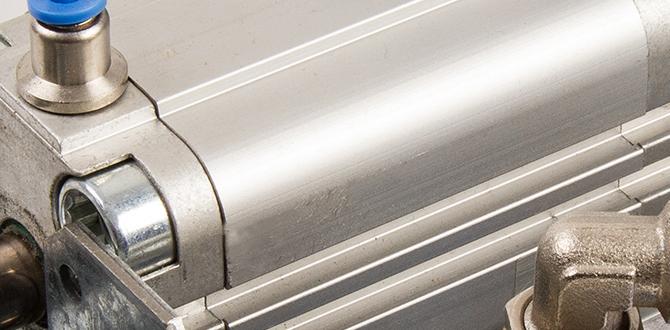For most DIYers, an angled finish nailer is the better, more versatile choice. It reaches tight spots and finishes trim work with more ease than a straight nailer. However, a straight nailer excels in specific applications like installing wider trim. This guide will help you pick the perfect nailer for your projects.
Hey there, fellow DIYer! Jack Shaffer here from Nailerguy. Ever stand in the aisle, staring at nail guns, feeling a little overwhelmed by the choices? I get it. One of the common head-scratchers is deciding between an angled finish nailer and a straight one. They both drive nails, right? But that little difference in angle can make a big impact on your projects, especially when you’re wrestling with tricky corners or beautiful crown molding. Don’t sweat it; we’re going to break it down simply, so you can pick the right tool and get back to building with confidence. Let’s make sure you’re not just nailing it, but nailing it right.
Table of Contents
Angled vs. Straight Finish Nailers: What’s the Big Deal?
At first glance, both angled and straight finish nailers look pretty similar. They’re designed to drive slim, headless nails (finish nails) perfect for trim work, cabinetry, and other tasks where you want a clean, hidden fastener. The main difference, as the names suggest, is the magazine – the part that holds the nails. A straight nailer’s magazine is, well, straight, meaning the nails sit in a perfectly vertical line. An angled nailer has a magazine that’s tilted, typically at either 15 or 20 degrees. This angle is the secret sauce that makes angled nailers incredibly useful. It allows the nailer head to sit flush against a surface while the nails are driven in at an angle, letting you reach into corners you’d otherwise have to fight with.
Why does this matter? Imagine trying to attach a piece of crown molding to a wall and ceiling. With a straight nailer, the magazine might bump against the ceiling before the head can get close enough to the wall to drive the nail securely. An angled nailer, however, can pivot around that corner, placing the nail exactly where you need it. It’s a small detail, but it can save you a lot of frustration and result in a much cleaner finish.
The Angled Nailer: Your New Best Friend for Trim
The angled finish nailer, often called a “tack nailer” or “miter nailer,” is incredibly popular for good reason. Its angled magazine is a game-changer for various woodworking tasks.
Key Advantages of Angled Nailers:
- Reaches Tight Spots: This is the big one! The angle allows the nail gun head to sit flush against surfaces, enabling you to drive nails into corners, around curves, and into tight spaces that a straight nailer would struggle with. Think about attaching baseboards where they meet a door frame, or working with intricate molding.
- Improved Access: For tasks like installing window casings or door jambs, an angled nailer lets you get into the nook between the frame and the wall more easily.
- Less Marring on Delicate Surfaces: Because the body of the nailer can often sit further away from the surface you’re working on while still driving the nail effectively, you might find it easier to avoid accidentally scratching or denting delicate wood.
- Versatility for Common Trim: Most standard trim profiles (like baseboards, chair rails, and crown molding) are designed with the understanding that fasteners can be driven at a slight angle without compromising their hold or appearance.
When to Choose an Angled Nailer:
If your DIY to-do list includes projects like:
- Installing crown molding
- Attaching baseboards
- Putting up chair rails
- Finishing window and door casings
- Building or attaching interior trim
- Working in tight cabinetry corners
Then an angled finish nailer is likely your best bet. It’s the workhorse for most interior trim applications.
The Straight Nailer: Specialized for Wider Applications
While the angled nailer gets a lot of love, the straight finish nailer still has its place. It’s generally simpler in design and can be more effective in specific scenarios, especially when dealing with wider trim or when precise nail placement in a straight line is critical.
Key Advantages of Straight Nailers:
- Ideal for Wider Trim: For very wide trim pieces, a straight nailer can drive nails in a straight line, distributing the holding power more evenly across the broader surface.
- Precise Nail Placement: When you need nails lined up perfectly straight, such as in certain furniture or paneling applications, a straight nailer gives you that control.
- Simpler Design, Potentially Lower Cost: Straight nailers can sometimes be less complex and therefore more affordable than their angled counterparts, though this isn’t always the case.
- Access in Wider Gaps: In situations where you have a slightly wider gap between two pieces of wood and need to drive a nail straight through from one to the other, a straight nailer can be easier to position.
When to Choose a Straight Nailer:
Consider a straight finish nailer if your projects primarily involve:
- Attaching wider, flatter decorative trim pieces.
- Specific furniture construction where nail lines are visible and need to be straight.
- Certain types of paneling installation.
- Situations where you’re fastening through wider boards and need the holding power distributed straight.
Understanding Nail Angles and Compatibility
The angle of the nailer’s magazine matters not just for access but also for the nails themselves. You need to use the correct type of nails designed for your specific nailer angle.
Common Nail Angles
The two most common angles for finish nailers are:
- 15-Degree Angles: These are often referred to as “coil nailers” because they traditionally used nails that came in coils, but most modern 15-gauge finish nailers use straight strips of nails. The angle is slightly less aggressive than 20 degrees.
- 20-Degree Angles: Sometimes called “offset” or “pass through” nailers, these have a more pronounced angle. This aggressive angle allows them to fit into even tighter spots and makes them excellent for reaching into corners.
Nail Compatibility is Crucial
It’s vital to use the right nails! Using the incorrect nails can lead to:
- Jamming: Nails that are too wide, too long, or not designed for an angled magazine will inevitably jam the tool.
- Poor Driving: The nail might not drive straight or could bend, failing to hold the material securely.
- Damage to the Nailer: Forcing incorrect nails can damage the driver blade or the magazine mechanism.
Always pick up nails specifically labeled for your nailer’s angle (e.g., “15-gauge nails for 15-degree nailers” or “20-gauge nails for 20-degree nailers”). For instance, you would buy 16-gauge nails for most 15-degree finish nailers and slightly different 16-gauge or even 14-gauge nails for some 20-degree models. Always check your nailer’s manual to be sure regarding gauge size and angle compatibility.
Power Source: Pneumatic vs. Cordless
Beyond the angle, how your nailer is powered is another significant decision. This affects portability, cost, and performance.
Pneumatic Finish Nailers
These are the traditional workhorses. They run off compressed air from an air compressor via a hose.
Pros:
- Consistent Power: Provide reliable, consistent power for driving nails.
- Lighter Tool Weight: The nailer itself tends to be lighter since the motor and power source are separate.
- Lower Initial Cost (often): If you already own an air compressor, a pneumatic nailer can be a more budget-friendly option.
- Durability: Generally very robust and long-lasting.
Cons:
- Requires an Air Compressor: You need a compressor, air hose, and potentially an air regulator, which adds to cost and setup time.
- Limited Portability: The hose restricts how far you can move.
- Noise: Air compressors can be loud.
- Setup Time: Connecting hoses, checking air pressure, etc., takes time.
A good resource for understanding air compressors and their role in powering tools is the U.S. Department of Energy’s guide on tools and equipment, which touches on the efficiency and selection of such systems.
Cordless Finish Nailers
These nailers are battery-powered and offer the ultimate in portability and convenience.
Pros:
- Maximum Portability: No hoses, no compressors. Just grab and go!
- Quick Setup: Ready to use in seconds.
- Clean Operation: No air leaks or hoses to manage.
- Convenient for Small Jobs: Perfect for quick fixes or working in areas without easy access to power.
Cons:
- Higher Initial Cost: The battery and brushless motor technology add to the price tag.
- Tool Weight: The battery adds heft to the tool.
- Battery Management: You need to keep batteries charged; power can sometimes be less consistent on a dying battery.
- Depth Control Can Vary: Some models might have less precise nail depth adjustment compared to high-end pneumatics.
- Output Limitations: For very rapid firing or driving into hardwoods, some entry-level cordless models might struggle compared to a robust pneumatic setup.
Think about your typical projects. If you’re frequently moving around a large house or working in areas far from an outlet, a cordless nailer is a dream. If you do a lot of trim work in one area and already have a compressor, pneumatic might be more cost-effective.
Key Features to Look For
When you’re comparing models, even within the angled or straight categories, several features can make your life easier and your work better.
1. Depth Adjustment
This is critical for driving nails to the perfect depth. You want to sink the nail head just below the surface for easy filling but not so deep that it craters the wood. Most nailers have a dial or lever for this. Look for one that’s easy to access and adjust on the fly.
A good depth adjustment system is key for a professional finish. Without it, you’ll be leaving nail heads proud of the surface or digging too deep, which can damage the wood and make for a difficult filling process.
2. Jam Release Mechanism
Nails can jam, it happens. A tool with an easy, tool-free jam release means you can clear a jam in seconds. Older models might require small hex wrenches and a lot of fiddling. Newer ones often have a lever or a simple latch you can flip.
3. Firing Mode (Sequential vs. Contact)
- Sequential (or Single) Firing: You must pull the trigger and press the nose of the nailer against the wood to fire one nail. This is the safest mode and ideal for precise placement.
- Contact (or Bump) Firing: You can keep the trigger pulled, and the nailer will fire a nail every time you bump the nose against the wood. This is much faster for applications like attaching trim quickly but requires more caution to avoid accidental firing.
Most finish nailers offer a switch to toggle between these modes. For trim work, having both is incredibly useful.
4. Nail Capacity
How many nails can the magazine hold? A higher capacity means fewer reloads. For a typical finish nailer, this usually ranges from 100 to 120 nails. Consider how often you find yourself reloading nails during a project and if a larger capacity would make a difference for you.
5. Swiveling Air Hose Connection (for Pneumatic)
If you opt for a pneumatic nailer, a swiveling connection for the air hose is a fantastic feature. It prevents the hose from getting tangled or kinked as you move around your workpiece, making the experience much smoother.
6. LED Light
Newer cordless models often include an LED light that illuminates your work area as you prepare to fire. This can be a lifesaver when working in dimly lit spaces, like under cabinets or in a crawl space.
Angled vs. Straight: A Quick Comparison Table
To help you visualize the differences, here’s a table summarizing the key points:
| Feature | Angled Finish Nailer | Straight Finish Nailer |
|---|---|---|
| Magazine Angle | Tilted (typically 15 or 20 degrees) | Straight (0 degrees) |
| Best For | Corners, tight spots, crown molding, baseboards, general trim work. | Wider trim, specific furniture components, paneling, straight-line fastening. |
| Access to Tight Areas | Excellent | Limited |
| Versatility (General Trim) | Higher | Lower |
| Nail Holding Power (Wide Trim) | Good, but straight can be better for very wide pieces. | Excellent for evenly distributing force on wide trim. |
| Nail Type | Specific nails designed for the angle (e.g., 15-gauge, 20-gauge). | Standard straight finish nails. |
| Tool Weight (typical) | Can be slightly heavier due to magazine design. | Can be slightly lighter. |
Choosing the Right Gauge
Finish nailers come in different gauges, which refers to the thickness of the nail. Two common gauges for finish nailing are 16-gauge and 18-gauge.
16-Gauge Finish Nailers
These are the most common for general trim work. The nails are fatter (about 1.6mm in diameter) and provide more holding power.
- Pros: Stronger hold, suitable for heavier trim, less likely to split wood when used with pilot holes or in softer woods.
- Cons: The nail head is larger, meaning the hole is more noticeable and requires a bit more filling.
- Applications: Baseboards, window and door casings, crown molding, heavier decorative trim.
18-Gauge Brad Nailers
While not strictly a “finish nailer” in the same category as 16-gauge, 18-gauge nailers (often called brad nailers) are sometimes used for very delicate trim work or where a nearly invisible fastener is needed. The nails are much thinner (about 1mm in diameter).
- Pros: Very small nail head, resulting in a nearly invisible fastener that requires minimal filling. Excellent for delicate moldings or intricate projects.
- Cons: Significantly less holding power. Not suitable for structural integrity or heavier trim pieces. Can sometimes bend or miss if driven at a severe angle.
- Applications: Small decorative trim, shoe molding, delicate craft work, attaching thin beadboard panels.
Jack’s Tip: For most general DIY trim projects around the house, a 16-gauge angled finish nailer is the sweet spot for balancing holding power and finish quality. If you’re doing extremely fine detail work or model building, an 18-gauge might be better, but for walls and typical home projects, stick with 16-gauge.
Safety First!
No matter which nailer you choose, safety is always paramount. Here are a few essential tips:
- Always wear safety glasses: Flying debris or accidental nail ricochets can cause serious eye injury.
- Read the manual: Understand your specific tool’s operation and safety features.
- Never point the nailer at yourself or others: Treat it like a loaded weapon.
- Engage sequential firing when precise placement is needed: This prevents accidental shots.
- Keep fingers away from the trigger and nose when not actively nailing.
- Ensure the area is clear: Make sure no one is behind the surface you are nailing into, as nails can sometimes pass through.
- Disconnect power (air or battery) when the tool is not in use, when clearing jams, or when




